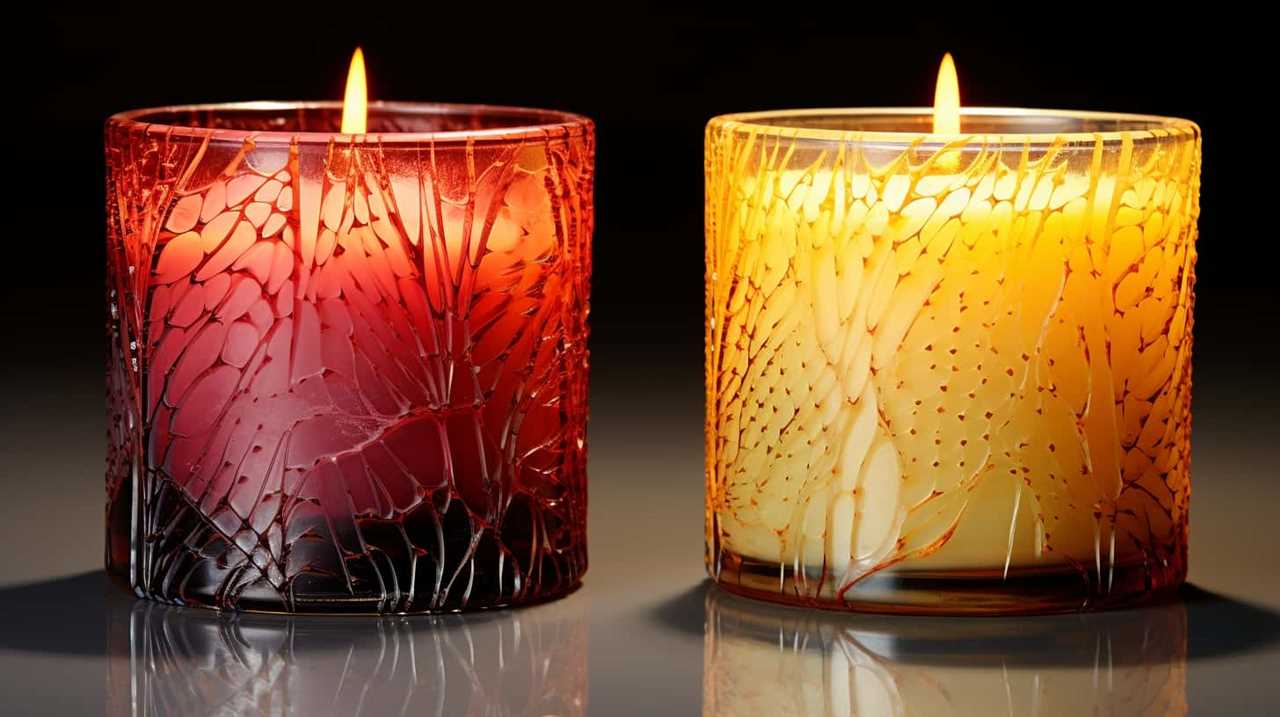We empathize with your question: “Why do we have to learn when to put out a candle? Can’t we just let it burn until it’s done?” Let us provide some insight on the topic.
Understanding when to extinguish a candle is a mark of true candle mastery. It’s not just about burning it until it’s gone, but rather about knowing when it’s time to bid farewell.
In this guide, we’ll walk you through the signs to look out for:
- When the wick is too short
- When soot accumulates
- When the scent becomes overpowering
- When the wax melts unevenly
- When the color changes
- When the flame flickers excessively
- When it burns too fast
- When the wax gets too close to the container’s edge.
So, let’s dive in and master the art of candle burning!

Key Takeaways
- Regularly trim the wick to prevent it from becoming too short and ensure a longer burn time.
- Use a sturdy candle holder to prevent tipping over and potential fires.
- Excessive smoke, flame flickering, and soot accumulation indicate health risks and safety concerns.
- Stop lighting the candle when the wax pool reaches a depth of about half an inch and when the scent becomes weak.
Candle Is Burning Low
We should consider extinguishing a candle when it’s burning very low, indicating that there’s only a small amount of wax left. It’s important to understand that continuing to burn a candle with a low level of wax can pose safety risks.
The wick may become unstable and burn too quickly, potentially causing the flame to grow larger than intended. This can result in an increased risk of fire and could also damage the candle holder or surrounding objects.
Therefore, it’s crucial to practice proper wick maintenance and regularly trim the wick to a quarter of an inch. Additionally, always keep a close eye on the candle and never leave it unattended.
Wick Is Too Short
When the wick of a candle is too short, it can cause several issues.

First, the fire won’t stay lit because there isn’t enough wick exposed to catch and sustain the flame.
Second, a short wick burns faster, leading to a shorter burn time for the candle.
Lastly, when the wick is too short, it becomes difficult to relight the candle once it has extinguished.
Fire Won’t Stay Lit
One reason for a candle’s fire not staying lit could be due to the wick being too short. When the wick is too short, it can’t draw up enough liquid wax to fuel the flame, causing it to extinguish quickly.

To maximize burn time and prevent wick tunneling, it’s important to ensure that the wick is properly trimmed to a suitable length before lighting the candle. To do this, use a wick trimmer or scissors to trim the wick to about 1/4 inch before each use.
This will help maintain a steady flame and allow the candle to burn evenly and efficiently. Remember, a properly trimmed wick is essential for achieving a long-lasting and consistent burn.
Wick Burns Too Fast
To address the issue of the wick burning too fast due to its short length, it’s crucial to lengthen the wick before lighting the candle. A short wick can lead to a fast burn, resulting in a shorter candle life and wasted wax. To solve this problem, consider replacing the wick with a longer one.
Wick replacement kits are available in most craft stores and online. When selecting a new wick, ensure it’s the correct size and thickness for your candle.

Additionally, proper candle storage can help prevent wick issues. Store candles in a cool, dry place away from direct sunlight to maintain their quality.
Difficult to Relight
To address the issue of a short wick making it difficult to relight a candle, we can take steps to ensure a longer burn time and maximize the lifespan of the candle. Here are some essential wick maintenance and relighting techniques to keep in mind:
- Trim the wick: Regularly trimming the wick to about 1/4 inch before each use can prevent it from becoming too short and hard to relight.
- Avoid drafts: Place the candle away from drafts, as they can cause the flame to flicker and shorten the wick.
- Use a long lighter: When relighting a candle with a short wick, a long lighter or matches can provide easier access to the wick.
By following these practices, you can maintain a longer wick and make relighting your candle a breeze. However, if the wick is consistently difficult to relight, it may be a sign that the candle has reached its endpoint and needs to be retired.
Now let’s discuss what happens when soot starts to accumulate.

Soot Starts to Accumulate
When soot starts to accumulate on the walls, furniture, or ceiling around a burning candle, it’s an indication that it’s time to address the issue.
Not only can soot be unsightly, but it can also pose health risks when inhaled.
To prevent excessive soot buildup, regular cleaning and maintenance of the candle and its surroundings are essential.
Health Risks of Soot
One significant health risk of burning candles is the accumulation of soot in the air. Soot is a black, powdery substance that’s released when candles burn. It can have several negative health effects, including:

- Respiratory problems: Inhaling soot particles can irritate the respiratory system, leading to coughing, wheezing, and shortness of breath.
- Allergies and asthma: Soot can trigger allergies and worsen symptoms in individuals with asthma or other respiratory conditions.
- Indoor air pollution: The accumulation of soot in the air can contribute to indoor air pollution, which can have long-term health effects.
To minimize the health risks associated with soot accumulation, it’s important to implement proper cleaning methods, such as regular dusting and vacuuming, to remove soot particles from surfaces. Additionally, ensuring proper ventilation in the room where candles are burned can help reduce the concentration of soot in the air.
Cleaning and Maintenance Tips
As we start to see soot accumulate from burning candles, we need to implement proper cleaning and maintenance tips to ensure a healthier environment. Cleaning your candle regularly not only removes the unsightly black residue but also helps in maximizing fragrance and preventing tunneling.
To clean the soot off the glass container, gently wipe it with a damp cloth or use a glass cleaner. For removing soot from the candle surface, trim the wick to 1/4 inch before each burn to prevent excessive soot buildup. Additionally, avoid burning candles in drafty areas and keep them away from fans or open windows.
By following these cleaning and maintenance tips, you can enjoy your candles without worrying about excessive soot or tunneling.

Now, let’s move on to the next topic: when your candle is producing a strong scent.
Candle Is Producing a Strong Scent
If the candle’s strong scent becomes too much, it may be time to extinguish it and consider alternative ways to create a pleasant atmosphere.
Now, let’s move on to the next subtopic: when the wax is unevenly melted.
Wax Is Unevenly Melted
When the wax of a candle is unevenly melted, it can pose a fire hazard risk. An uneven melt can cause the flame to become too high and flicker, increasing the chance of the candle tipping over or catching nearby objects on fire.

Additionally, an uneven melt can also result in a shorter burn time, as the unmelted wax may not be able to reach the wick, causing the candle to extinguish prematurely.
Fire Hazard Risk
We must address the fire hazard risk associated with candles when the wax is unevenly melted. This is an important issue to consider, as it can lead to potential health effects and pose a danger to both people and property. To ensure safety, it’s crucial to take preventive measures when dealing with unevenly melted wax. Here are some key points to keep in mind:
- Trim the wick: A longer wick can cause the flame to grow too large and increase the risk of a fire.
- Use a candle holder: Placing the candle in a sturdy, heat-resistant holder will prevent it from tipping over and causing a fire.
- Monitor the candle: Never leave a burning candle unattended, especially when the wax is unevenly melted.
By following these prevention measures, you can minimize the fire hazard risk associated with candles.
However, there’s another factor to consider: the shorter burn time.

Shorter Burn Time?
To address the issue of a shorter burn time when the wax is unevenly melted, it’s important to consider the potential risks and necessary precautions. Uneven melting can result in a candle burning out faster than expected, reducing the maximum fragrance and overall lifespan of the candle.
When a candle’s wax doesn’t melt evenly, it can create a tunneling effect. This means that the candle burns straight down in the center, leaving a thick wall of unmelted wax around the sides. This not only limits the fragrance release but also reduces the burn time.
To maximize fragrance and extend the candle’s lifespan, it’s crucial to ensure even wax melting. To achieve this, always trim the wick to ¼ inch before lighting the candle. Additionally, allow the candle to burn for a sufficient amount of time so that the entire top layer of wax melts evenly. This will promote a consistent burn and help avoid the issue of a shorter burn time due to uneven wax melting.
Flame Becomes Unstable
Once the flame starts flickering erratically and losing its steady glow, it’s time to consider extinguishing the candle. An unstable flame not only poses health risks but can also lead to accidents and damage.

Here are some reasons why a flame becomes unstable and what you can do about it:
- Drafts: Ensure that there are no drafts around the candle, as they can cause the flame to flicker and become unstable. Consider moving the candle to a more sheltered location.
- Wick length: Trim the wick to about 1/4 inch before lighting the candle. A long wick can create a larger flame that’s more prone to flickering.
- Candle cleanliness: Keep the candle clean by removing any debris or excess wax that may obstruct the flame. This will help maintain a steady and stable burn.
Candle Has Reached Its Recommended Burn Time
When a candle has reached its recommended burn time, it’s important to consider safety concerns and maximize the lifespan of the candle. Overburning a candle can increase the risk of fire and cause the flame to become unstable.
Safety Concerns With Overburning
Our concern with overburning a candle, once it has reached its recommended burn time, is primarily focused on safety. Continuing to burn a candle beyond its recommended time can pose various health risks and safety hazards. Here are some of the key concerns to consider:
- Health Effects:
- Extended exposure to candle emissions can lead to respiratory problems and irritate the lungs.
- Prolonged inhalation of toxic substances emitted by an overburned candle may cause headaches, dizziness, and nausea.
- Proper Ventilation:
- Overburning a candle without proper ventilation can increase the concentration of pollutants in the air, leading to indoor air pollution.
- Lack of ventilation can also contribute to the buildup of soot on walls, ceilings, and furniture.
It is important to be mindful of these safety concerns to protect your health and maintain a safe environment.
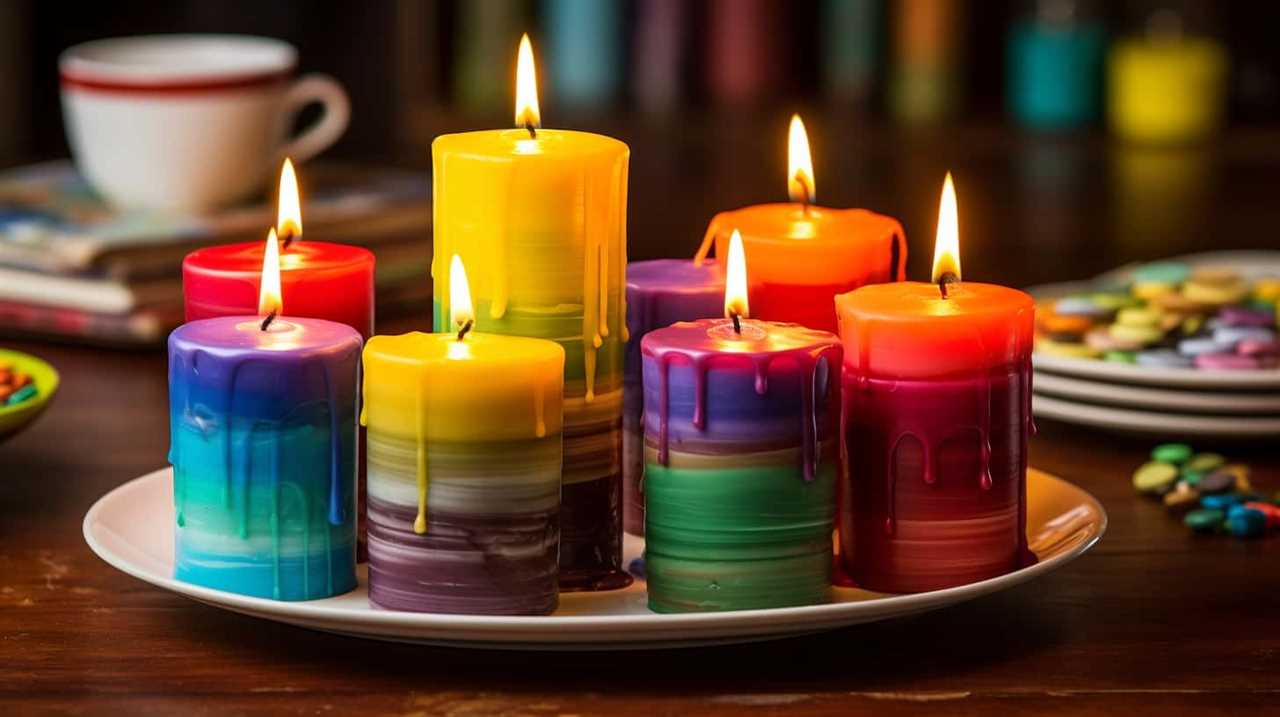
Now, let’s explore how to maximize the lifespan of your candle.
Maximizing Candle Lifespan
To ensure the longevity of a candle that has reached its recommended burn time, we can implement certain strategies.
One way to maximize fragrance and prevent tunneling is to trim the wick before each use. This helps to maintain an even burn and prevents the candle from producing excess smoke.
Additionally, using a candle snuffer instead of blowing out the flame can help to minimize soot and preserve the candle’s fragrance.
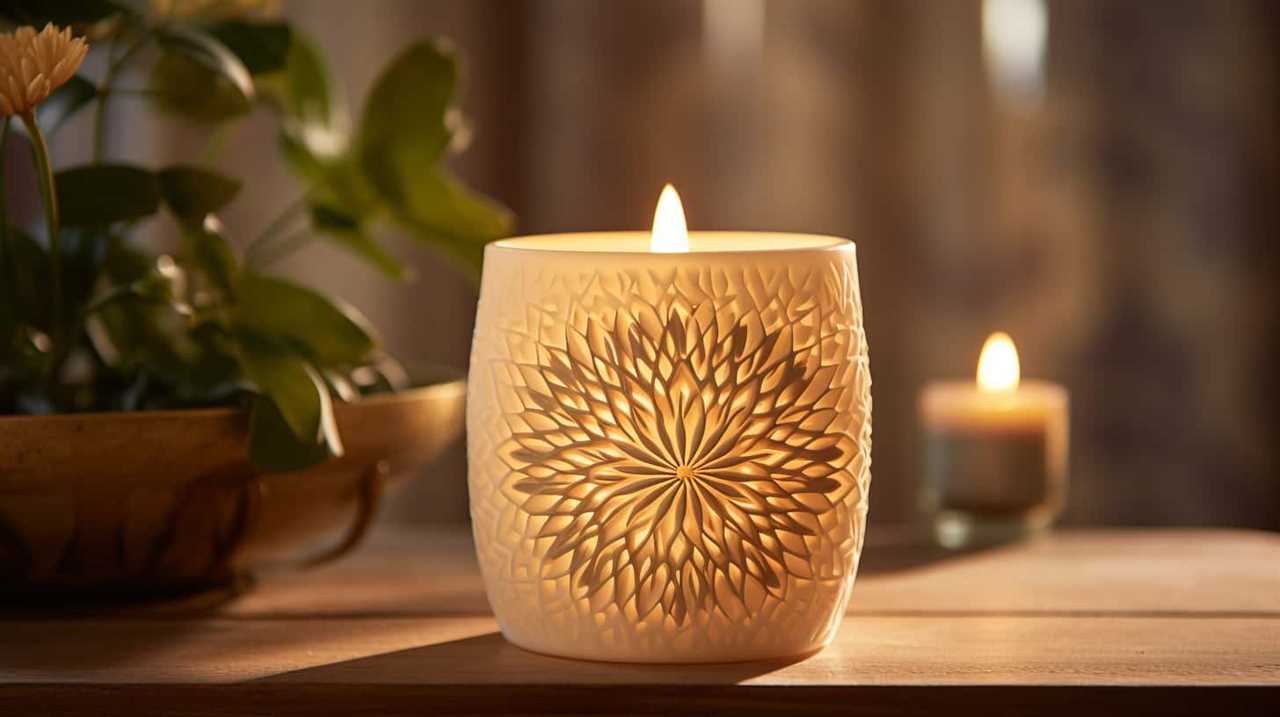
Another tip is to avoid burning the candle for more than four hours at a time, as this can cause the wax to overheat and reduce its lifespan.
Finally, placing the candle in a draft-free area and keeping it away from direct sunlight can also help to prolong its fragrance and prevent tunneling.
Wax Pool Is Too Deep
The depth of the wax pool becomes a concern when it impedes the proper burning of the candle. When the wax pool is too deep, it can lead to several issues that affect both the performance and safety of the candle. Here are some reasons why a deep wax pool is problematic:
- Uneven burning: A deep wax pool can cause the candle to burn unevenly, resulting in wasted wax and an inefficient use of the candle.
- Increased soot: Deeper pools of wax can produce more soot, which can lead to a dirty and smoky environment.
- Fire hazard: If the wax pool becomes too deep, it can overflow and potentially ignite nearby objects, posing a fire risk.
To prevent these issues, it’s recommended to trim the wick and extinguish the candle when the wax pool reaches a depth of about half an inch. Alternatively, consider exploring alternative options such as flameless candles or diffusers to enjoy the health benefits of aromatherapy without the concerns of a deep wax pool.

Scent Is No Longer Noticeable
As the candle continues to burn, we may notice that the scent becomes less and less noticeable over time. This is because the fragrance strength of the candle diminishes as it burns. The burning time of a candle greatly affects how long the scent will last. Different candles have different burning times, but on average, a candle can burn for about 20 to 30 hours. However, the fragrance strength usually starts to diminish after about 10 hours of burning time. To better understand this concept, refer to the table below:
| Burning Time | Fragrance Strength |
|---|---|
| 0-10 hours | Strong |
| 10-20 hours | Moderate |
| 20-30 hours | Weak |
Once the scent of the candle becomes weak, it is a good indication that it is time to stop lighting it, as you may no longer be able to enjoy the aromatic experience.
Wick Is Difficult to Light
After the fragrance strength of the candle has diminished, we may encounter difficulty in lighting the wick. This can happen for various reasons, including the wick being damaged or becoming difficult to ignite. Here are some possible causes for a difficult-to-light wick:
- The wick has become too short: Over time, the wick may burn down and become too short to easily ignite. Trimming the wick to a suitable length can help resolve this issue.
- The wick has become clogged: If the candle has been exposed to dust or debris, the wick may become clogged, making it harder to light. Cleaning the wick or removing any obstructions can solve this problem.
- The wick has become frayed or damaged: If the wick is damaged or frayed, it may not catch fire easily. In such cases, replacing the wick with a new one is necessary.
When encountering difficulty in lighting a candle’s wick, it’s important to address the issue promptly to ensure a safe and enjoyable candle-burning experience.

Candle Is Producing Excessive Smoke
Once the wick is difficult to light, we may notice that the candle is producing excessive smoke. Excessive smoke from a burning candle can be a cause for concern, as it may indicate health risks associated with soot and safety concerns with overburning.
The smoke produced by a candle contains tiny particles of soot, which can be harmful when inhaled. These particles can irritate the respiratory system and may aggravate existing conditions such as asthma or allergies.
Additionally, overburning a candle can lead to the excessive production of smoke, increasing the risk of fire hazards and indoor air pollution. It’s important to address these issues by extinguishing the candle and ensuring proper ventilation in the area.
Wax Color Starts to Change
When the wax color starts to change, we can tell that the candle has been burning for a significant amount of time. The wax discoloration indicates that the candle has reached a point where it may not burn as effectively as before. Here are some reasons why the wax color might change and what it means:

- Overheating: If the candle is exposed to excessive heat, the wax can melt unevenly, resulting in discoloration. This can be a sign that the candle should be extinguished to prevent any safety hazards.
- Fragrance fading: Some scented candles may experience wax discoloration as the fragrance oils evaporate. This can be an indication that the candle has lost its potency and won’t provide the desired scent.
- Chemical reactions: Certain candle dyes or additives can react with the heat and cause the wax to change color. If the discoloration is accompanied by an unusual scent, it’s best to stop lighting the candle to avoid any potential harmful effects.
When the wax color starts to change, it’s a sign that the candle has reached its limit and should be replaced or extinguished to ensure safety and optimal performance.
Flame Is Flickering Excessively
Our candle’s flame flickering excessively signals a potential issue that needs attention.
When a candle’s flame is flickering excessively, it may indicate the presence of excessive soot. Excessive soot can pose health risks, as it can release harmful chemicals and pollutants into the air.
To prevent soot accumulation, there are a few tips you can follow.

Firstly, trim the wick to 1/4 inch before each use to ensure a steady flame.
Secondly, avoid placing the candle in a drafty area, as this can cause the flame to flicker excessively.
Lastly, make sure to burn the candle for at least one hour each time to prevent tunneling and ensure an even burn.
Candle Is Burning Too Fast
To address the issue of a candle burning too fast, we can take measures to prolong its burn time. Here are some candle burning techniques that can help you maximize the life of your candle:
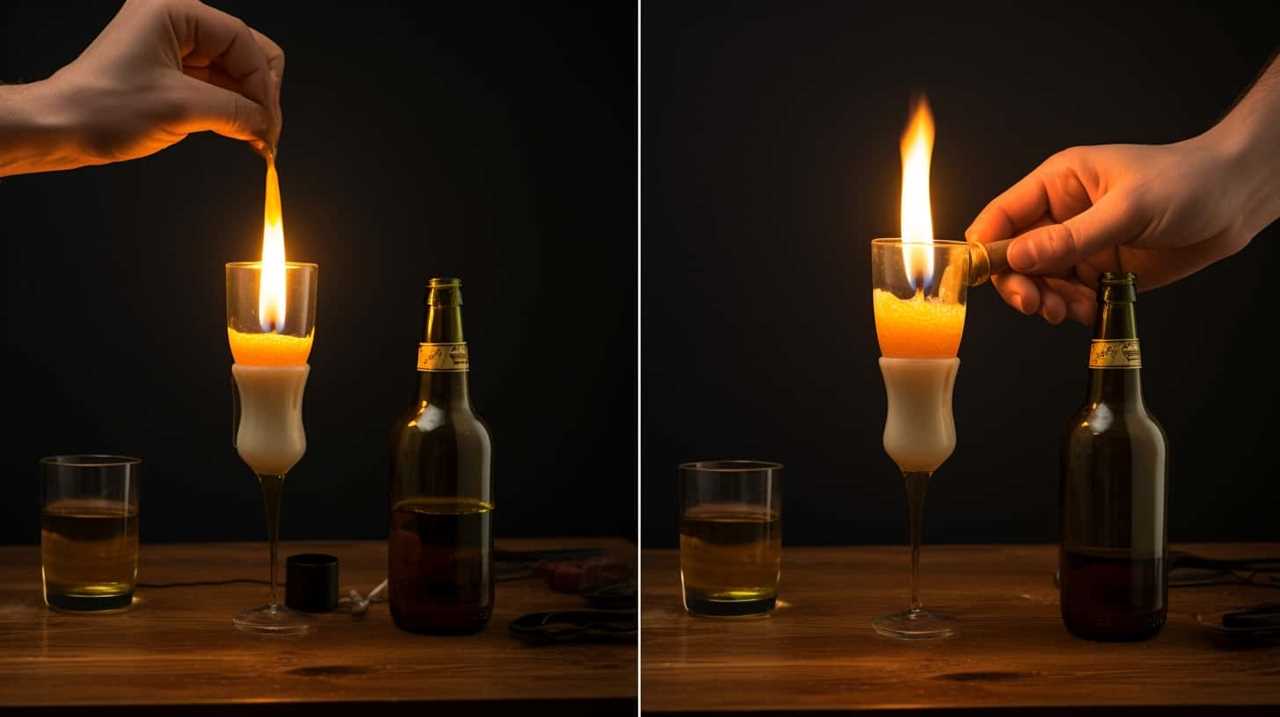
- Trim the wick: A long wick can cause the candle to burn faster. Trim the wick to about ¼ inch before lighting to ensure a slower burn.
- Use a candle snuffer: Blowing out a candle can create smoke and cause the wax to melt unevenly. Use a snuffer to extinguish the flame gently and prevent unnecessary wax loss.
- Avoid drafts: Drafts can accelerate the burning process. Keep your candle away from open windows or vents to maintain a steady burn.
By implementing these techniques, you can prolong the life of your candle and enjoy its warm glow for longer periods.
Remember to always practice candle safety and never leave a burning candle unattended.
Wax Is Close to the Container’s Edge
To address the issue of a candle burning too fast and prolong its burn time, one technique is to ensure that the wax isn’t close to the container’s edge. When the wax is close to the edge, it can lead to tunneling, which is when the candle burns straight down in a narrow tunnel, leaving a significant amount of unused wax on the sides.
This not only reduces the overall burn time but also wastes a substantial portion of the candle. To maximize burn time and prevent tunneling, it’s crucial to trim the wick to a quarter of an inch before each use and allow the wax to melt evenly across the container.

Frequently Asked Questions
How Can I Prevent the Wick From Becoming Too Short?
To prevent the wick from becoming too short and prolong the candle’s burn time, we can trim the wick to 1/4 inch before each lighting. This ensures a steady flame and reduces the risk of the wick extinguishing prematurely.
What Can I Do if My Candle Is Producing a Strong Scent That Is Overwhelming?
When a candle overwhelms with scent, we address it by checking the fragrance strength, placing the candle in a larger space, or using a candle warmer. If there’s no scent, we can try trimming the wick or using a different brand.
Why Is My Candle Producing Excessive Smoke?
Excessive smoke from a candle can have common causes like a dirty wick, drafty environment, or low-quality wax. To troubleshoot, try trimming the wick, moving the candle away from drafts, or using a higher quality candle.
What Causes the Wax Color to Change?
When does one extinguish a candle? Let us enlighten you. The color of the wax changes due to various factors, such as temperature. Different temperatures can result in a beautiful array of hues.

How Can I Make My Candle Burn Slower?
To extend the life of your candle and make it burn slower, try these candle maintenance tips: trim the wick regularly, avoid drafts, and allow the wax to melt evenly. This will ensure a longer-lasting and more enjoyable experience.
Conclusion
When the flame flickers wildly, the wax melts unevenly, and the scent becomes overpowering, it’s time to bid farewell to your candle.
Like a weary dancer, its wick shortens, its color changes, and soot gathers like a heavy cloud.
Listen to the whispers of your senses, for they’ll guide you.
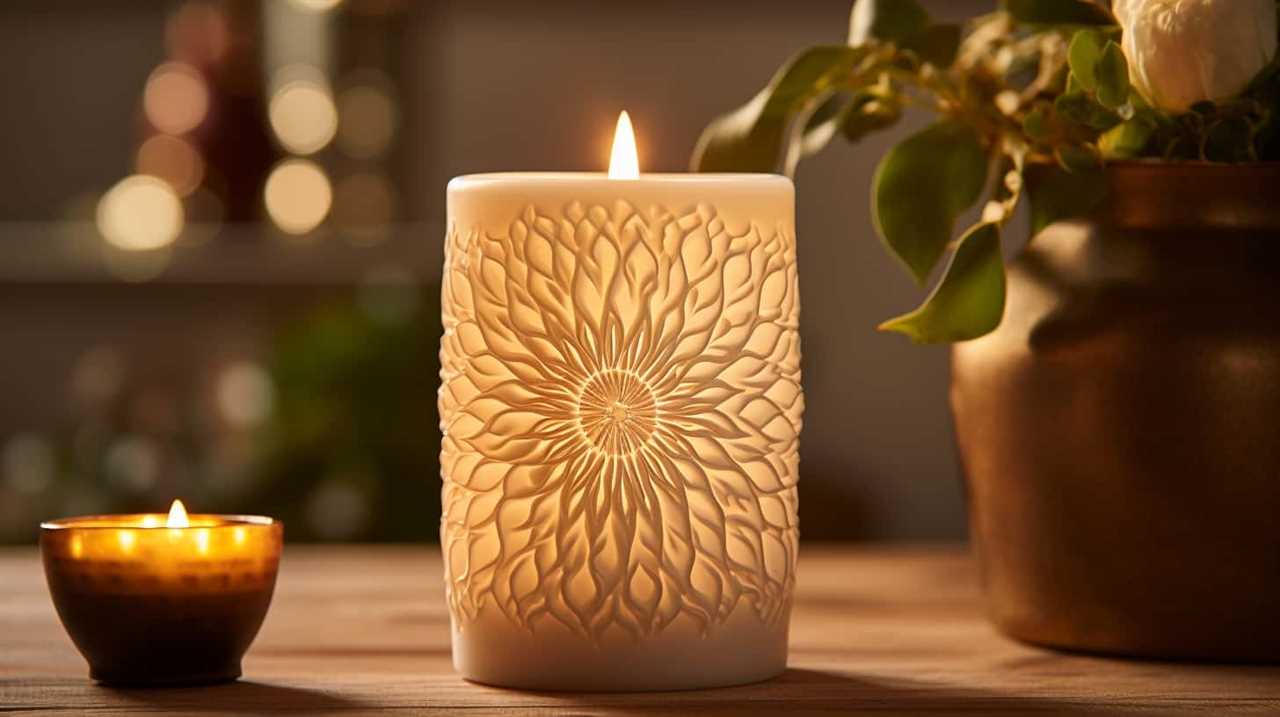
Let the candle’s final flicker remind you of the beauty it brought, and with gratitude, extinguish its flame.
